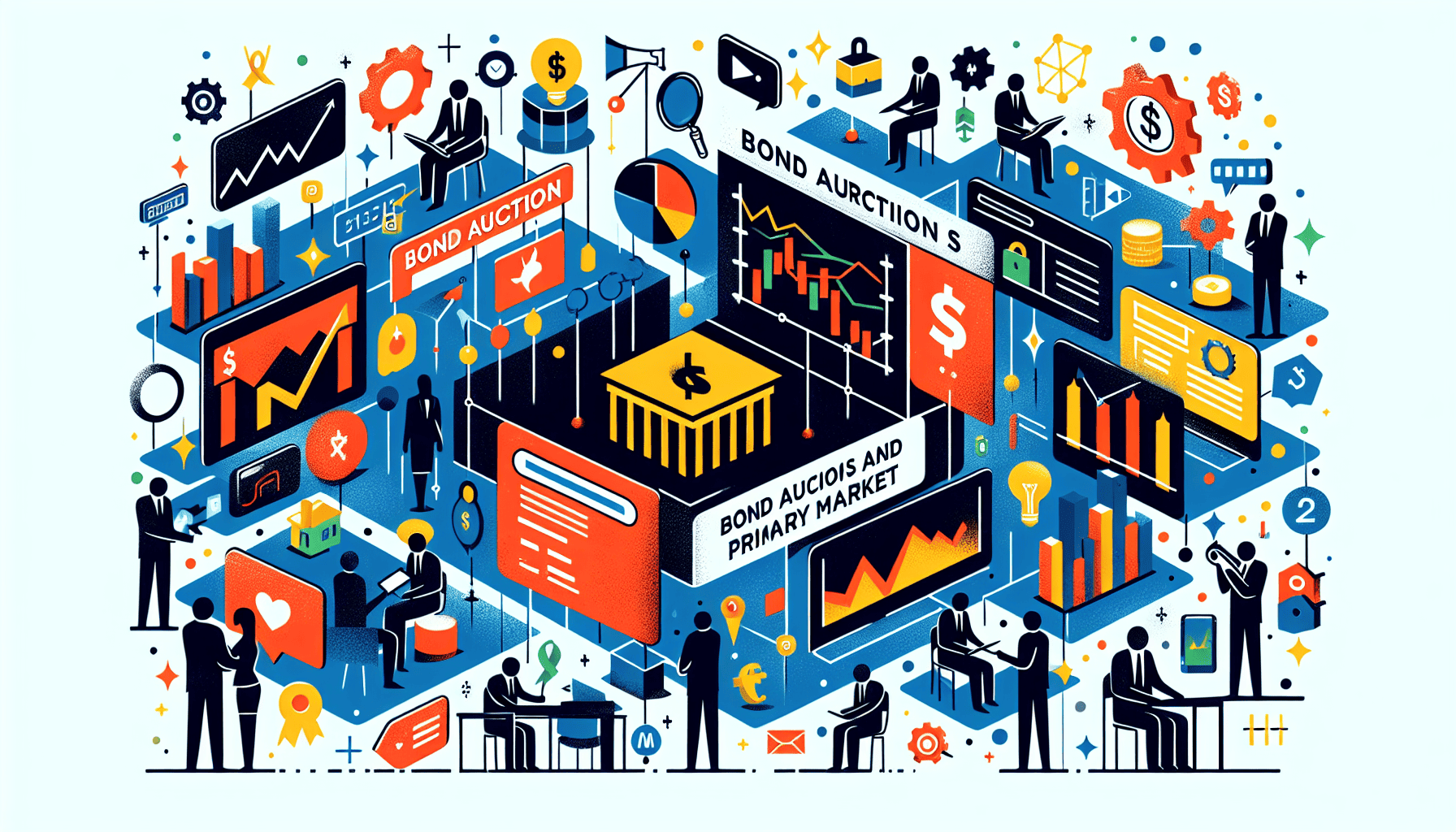Securing Investment Opportunities: Delving into Bond Auctions and the Primary Market

Introduction to Bond Markets
The bond market is a pivotal component of the global financial system. It offers a mechanism for governments and corporations to acquire capital while providing investors with opportunities for preservation and growth of wealth.
What are Bonds?
Bonds are debt instruments representing a loan made by an investor to a borrower, typically corporate or governmental. A bond could be viewed as an IOU between the lender and borrower that includes the details of the loan and its payments. Bonds are equipped with a fixed interest rate—also known as a coupon—which is paid at specified intervals to the holder, and a maturity date, at which point the principal amount must be paid back.
| Bond Component | Description |
|---|---|
| Principal | The face value of the bond to be repaid at maturity |
| Coupon Rate | The interest rate that the bond issuer pays to the bondholder |
| Maturity | The date on which the principal amount of a bond becomes due and is repaid to the investor |
Bonds come in various forms, such as inflation-protected bonds known as Treasury Inflation-Protected Securities (TIPS), municipal bonds that offer tax advantages, and high-yield bonds that carry higher risk but the potential for greater returns. Each type offers distinct features and levels of risk, making them suitable for different investment strategies.
Role of Bond Markets
Bond markets serve a critical function in the financial ecosystem by facilitating the transfer of capital from investors to entities requiring funding. These entities issue bonds to finance operations, projects, or refinance existing debts. The primary market is where these new securities are initially offered and sold to investors, providing a direct way for borrowers to obtain funds (Investopedia).
The bond market is also an indicator of economic health, with interest rates reflecting the country’s economic outlook. For instance, the U.S. Treasury operates the world’s largest primary market, issuing a range of securities to fund government expenditures, which are key indicators for the overall market (Investopedia).
Investors turn to the bond market for the relative safety and predictability of fixed income. Bonds are considered a cornerstone of a diversified investment portfolio, often balancing the volatility of stock investments. Understanding the basics of bond investing is essential for any investor looking to navigate the bond market effectively.
The bond market’s influence extends beyond investment returns. It plays a significant role in global economic stability and development by providing a mechanism for government funding and institutional borrowing. The funds raised through bond markets can cover budget deficits, finance infrastructure projects, and manage public-sector borrowing requirements, making it a cornerstone of fiscal policy (Investopedia).
Bond markets are also a hub for various investment strategies, such as bond laddering and portfolio diversification through international bonds. Investors and financial professionals must understand the market’s intricacies, including bond valuation techniques, credit risk, interest rate risks, and the role of rating agencies in assessing bond quality.
By understanding the fundamentals of the bond market, beginner investors can make informed decisions and develop strategies that align with their financial goals and risk tolerance. Whether seeking stability, income, or diversification, the bond market offers a variety of instruments to meet the needs of any investor.
Understanding Bond Auctions
Bond auctions play a pivotal role in the primary market, where the process of issuing new securities and determining their yield takes place. For beginner investors, grasping the mechanics of bond auctions is essential for navigating the world of finance and making informed investment decisions.
Auction Types
The U.S. Department of the Treasury conducts regular auctions to sell Treasury bills, notes, and bonds to the public, which are a crucial component of managing the country’s debt (Investopedia). There are two main types of auctions:
- Competitive Auctions: Bidders specify the yield they are willing to accept for the securities. The highest bids that fall under the total amount of securities offered are accepted first until all securities are allocated.
- Noncompetitive Auctions: Bidders agree to accept the yield as determined by the outcome of the competitive auction. These bids are guaranteed to be fulfilled as long as they are below the maximum allowed purchase amount.
Internationally, auction formats vary, with 39 out of 42 countries utilizing the ‘pay your own bid’ or discriminatory auction, while the remaining three employ a ‘single price’ or uniform price auction.
Bidding Process
The bidding process is integral to bond auctions, where investors submit bids to purchase the securities issued by the Treasury.
- Competitive Bidders: They must specify the exact yield they are willing to accept. These bids are ranked, and the lowest yields (highest prices) win until the entire offering amount is allocated.
- Noncompetitive Bidders: They agree to accept the yield as determined by the competitive bids, with the assurance that their bids will be fulfilled up to certain limits, making it an attractive option for smaller investors.
For a deeper understanding of how these bids impact your investment strategy, explore bond laddering strategy and bond valuation techniques.
Determining the Yield
The yield on Treasury securities is determined by the competitive bidding during the auction. The highest bids with the lowest yields are accepted until the entire quantity of the bond issue is allocated. The process ensures that the government’s borrowing costs reflect the current market conditions. The yield set at auction becomes the benchmark for various other investments in the financial markets.
| Auction Type | Bidding Method | Yield Determination |
|---|---|---|
| Competitive | Bidder specifies yield | Lowest yields accepted until quantity met |
| Noncompetitive | Bidder accepts market yield | Yield determined by competitive bids |
Investors interested in the bond market can further explore topics such as government bonds: stability and security, as well as the nuances of corporate bonds: risks and rewards, to better understand the diversity within bond auctions and the primary market. Additionally, strategies for a fixed income portfolio and interest rate risks in bond investing can offer insights into managing bond investments effectively.
Primary Market Explained
The primary market serves as the foundational platform for the issuance of new securities, where governments and corporations obtain funding directly from investors. This market is a critical component of the financial system, providing a structured environment for raising capital through the sale of financial instruments such as bonds.
Issuing New Securities
In the primary market, new debt securities, such as bonds, are issued and sold to investors for the first time. This process is essential for borrowers to raise capital to fund operations, invest in projects, or manage debts. Unlike the secondary bond market dynamics, where existing securities are traded, the primary market deals exclusively with new issues (Investopedia).
Securities can be issued by various entities, including governments, municipalities, and corporations. Each of these issuers has different purposes for raising funds, such as financing infrastructure projects, corporate expansions, or managing public debt. For example, government bonds offer stability and security, whereas corporate bonds may carry higher risks but also potentially higher rewards.
Investor Participation
Investor participation in the primary market is diverse, encompassing banks, financial institutions, pension funds, individual investors, and foreign entities. Each investor type brings unique perspectives and risk appetites to the market. Individual investors, for example, may be more inclined towards inflation-protected bonds or municipal bonds for their tax-advantaged status.
Investors can participate in bond auctions through competitive and noncompetitive bidding. Competitive bidders specify the yield they are willing to accept, while noncompetitive bidders agree to accept the yield determined by the auction’s outcome, ensuring their participation without the need to actively bid (New York Fed).
Role of Treasury Auctions
Treasury auctions are a primary method through which the U.S. government raises funds to finance its operations and manage the national debt. Regular auctions are held to sell Treasury bills, notes, and bonds to the public. The auction process is crucial as it determines the interest rates and prices of these securities, directly influencing the country’s fiscal policy (Investopedia).
These auctions can be broken down into different cycles, with varying maturities to meet the investment strategies and liquidity needs of different investor groups. For instance, Treasury bills are short-term securities, while Treasury bonds are long-term. Non-competitive bidding options allow smaller investors to participate in these auctions at a guaranteed yield, contributing to the inclusivity and accessibility of bond markets (Investopedia).
Bond auctions and the primary market are integral components of the broader financial markets, providing a structured process for raising capital and offering investment opportunities. By understanding the mechanisms of the primary market, beginner investors can better navigate the basics of bond investing and develop strategies such as bond laddering for their portfolios.
Secondary Market Dynamics
The secondary market plays a pivotal role in the bond ecosystem, allowing investors to buy and sell previously issued debt securities. Understanding the dynamics of this market can be critical for beginner investors looking to navigate through the world of bonds.
Buying and Selling Bonds
In the secondary bond market, investors trade bonds among themselves, rather than with the issuing entity. This market provides the flexibility to adjust investment positions in response to changing financial goals or market conditions. Bonds can range from government bonds offering stability and security to high-yield bonds, also known as junk bonds, which carry higher risk but potentially greater rewards.
The process of buying and selling bonds in the secondary market is facilitated by brokers or online trading platforms. Transactions can be conducted over-the-counter (OTC) or through a formal exchange. The price of a bond in this market reflects its current market value, which may differ from its face value based on various factors including changes in interest rates, credit ratings, and the bond’s remaining time to maturity.
Price Discovery
Price discovery is the mechanism by which the secondary market establishes the price of bonds based on the current supply and demand dynamics. As Investopedia notes, investors utilize this transparent process to gauge the market value of bonds, ensuring that the prices reflect all available information.
Investors and analysts employ bond valuation techniques to determine the fair value of a bond. These techniques consider the bond’s cash flows, duration, yield to maturity, and credit risk. Price discovery is a continuous process, and the resulting bond prices serve as a benchmark for both issuers and investors in assessing the cost of debt and the return on investment.
Market Liquidity
Market liquidity refers to the ease with which bonds can be bought or sold in the market without causing significant changes in their prices. Liquidity is crucial for investors as it ensures that they can transact in a timely manner. According to the IMF, liquidity in government securities is particularly important for maintaining stability and providing a benchmark for risk-return evaluations.
High liquidity is associated with a market where there are many buyers and sellers, and transactions can be completed quickly at prices that reflect the true value of the bonds. Conversely, low liquidity can lead to larger price fluctuations and may make it more difficult for investors to execute trades at their desired price.
| Market Type | Characteristics |
|---|---|
| Liquid Market | Many buyers/sellers, small price impact, quick transactions |
| Illiquid Market | Few buyers/sellers, larger price impact, slower transactions |
For those looking to delve deeper into how market liquidity affects bond investments, secondary bond market dynamics provides a comprehensive overview.
Navigating the secondary market requires an understanding of these key concepts. By grasping the nuances of buying and selling bonds, price discovery, and market liquidity, beginner investors can make informed decisions and strategically manage their bond portfolios, whether they’re interested in municipal bonds for tax advantages or exploring international bonds for global diversification.
Auction Mechanisms and Strategies
Navigating the intricacies of bond auctions and the primary market is fundamental for beginner investors to grasp the forces that shape investment opportunities. This section delves into the bidding strategies, the role of primary dealers, and how these auctions influence governmental fiscal policy.
Competitive vs. Noncompetitive Bidding
Bond auctions typically involve two types of bidding: competitive and noncompetitive. In competitive bidding, investors specify the yield they are willing to accept, and this process helps to determine the yield on the securities. The highest yielding (lowest priced) acceptable bids win the securities. Conversely, noncompetitive bidders agree to accept the yield as determined by the outcome of the competitive bids. This option is often preferred by individual investors who are willing to accept the market yield and want to avoid the complexity of determining the right bid (New York Fed).
| Bid Type | Description | Typical Bidders |
|---|---|---|
| Competitive | Specify yield, determine auction yield | Institutional Investors |
| Noncompetitive | Accept market yield, no specific bid | Individual Investors |
Understanding these bidding processes is essential for investors interested in government bonds and Treasury securities.
Influence of Primary Dealers
Primary dealers are a central component in Treasury auctions, playing a pivotal role in the primary bond market. They have the advantage of observing the willingness-to-pay of their customers who route their bids through them. Research indicates that primary dealers consistently bid for higher yields (lower prices) compared to other bidders, potentially due to their substantial size and market share, which allows them to exert more influence on the market and modify their bids accordingly. This activity can have a significant effect on the yields and pricing of newly issued securities.
Impact on Fiscal Policy
The efficiency of bond auctions carries implications for fiscal policy. Losses in allocative efficiency are generally modest, with an average of just above 2 basis points. However, these figures suggest that even minor adjustments in the auction mechanism could influence the government’s borrowing costs. By optimizing the auction process, fiscal policy can be indirectly affected, potentially leading to cost savings for the government and impacting broader economic policies (source).
For investors, understanding these mechanisms is crucial when building a fixed income portfolio or considering investments in corporate bonds and municipal bonds. The strategies and dynamics of bond auctions reflect the complex interplay between market participants and government entities, shaping the landscape of investment opportunities in the bond markets.
Technological Advancements
Technological progress has significantly impacted the bond markets, particularly in the arenas of bond auctions and the primary market. These advancements have streamlined processes, bolstered transparency, and enhanced the overall efficiency of bond trading.
Electronic Auction Platforms
Electronic auction platforms have revolutionized the way bonds are issued and purchased in the primary market. The TreasuryDirect system, introduced in 2002, is a prime example, allowing individual investors to partake directly in Treasury auctions by submitting non-competitive bids. This innovation has democratized the bidding process, enabling wider participation beyond institutional investors New York Fed.
According to the IMF, the adoption of electronic platforms in the primary market has surged in recent years. These platforms facilitate the auction process by providing real-time data, streamlining bid submissions, and offering a secure environment for transactions. Furthermore, the platforms have been instrumental in expanding the investor base for government securities, drawing a diverse group of participants from around the globe.
The table below illustrates the growth in electronic platform usage for bond auctions:
| Year | Percentage of Auctions Conducted Electronically |
|---|---|
| 2002 | 25% |
| 2007 | 60% |
| 2012 | 85% |
| 2017 | 95% |
| 2021 | 98% |
Estimates based on market trends
Transparency and Efficiency
The surge in technological innovation has also resulted in increased transparency and efficiency within bond markets. Market participants now have access to more information than ever before, allowing them to make more informed decisions when it comes to bidding on and purchasing bonds.
The New York Fed highlights that the improved transparency and innovation in Treasury auctions have fostered competitive bidding and a more efficient primary market for marketable Treasury securities. Moreover, efficiency losses in US Treasury auctions are relatively modest, with an average of just above 2 basis points, suggesting that the primary markets for government securities are operating near optimally. This low margin of potential improvement underscores the effectiveness of the current auction mechanisms source.
To further understand the dynamics of bond markets, readers may explore bond valuation techniques and delve into the secondary bond market dynamics to gain insight into how bonds are traded after their initial issuance. Additionally, for those interested in the broader aspects of bond investing, the basics of bond investing provide foundational knowledge crucial for beginner investors.
The ongoing evolution of technology in bond markets continues to shape the future of investing. As electronic platforms become increasingly sophisticated, the bond markets are expected to become even more accessible, transparent, and efficient, benefiting all market participants. To stay abreast of these changes and their implications, one can follow the developments in the future of bond markets.
Global Perspectives
The global bond market offers a wide array of practices and trends that can influence investment strategies and fiscal policies. By examining international auction practices and bond issuance trends, investors can gain a better understanding of the complexities and opportunities within the bond markets.
International Auction Practices
When considering bond auctions and the primary market on a global scale, there is a lack of consensus on the optimal auction format for government securities. According to a study, 39 out of 42 countries use the ‘pay your own bid’ or discriminatory auction approach, while the remaining three employ a ‘single price’ or uniform price auction (source). These practices can vary widely, reflecting each country’s unique economic conditions and market dynamics.
In the United States, for example, primary dealers consistently bid higher yields (lower prices) than other participants in the Treasury auctions, possibly due to their larger size and market share which grants them more market power (source). This observation highlights the influence primary dealers can have on auction outcomes and the importance of understanding the role they play in bond markets.
For more insights into the roles of different market participants, readers may explore the role of primary dealers and their impact on market efficiency and fiscal policy.
Bond Issuance Trends
Bond issuance trends are a key indicator of the health and direction of financial markets. Advanced countries, such as the United States and the UK, have historically pre-announced an annual schedule of bond issuance. This practice reduces market uncertainty, provides transparency, and bolsters investor confidence, allowing market participants to plan their investments (IMF).
In contrast, emerging markets have shown varied patterns in their bond issuance practices. For instance, Indonesia witnessed a significant increase in primary market issuance volume after the first quarter of 1997, highlighting the country’s growing reliance on bond markets for financing (IMF). Romania, too, saw a notable surge in primary market issuance from virtually no activity in 1996 to an average monthly issuance of 0.7% of GDP by the end of 1999, indicating a rapid development in its bond market infrastructure (IMF).
The trends in bond issuance can also reflect broader economic changes, as seen in Russia’s shift of treasury bill issuance from the Central Bank to the Federal Treasury and the introduction of structured bonds with minimum denomination requirements in the primary market (IMF).
Investors interested in diversifying their portfolios can learn more about the benefits and considerations of investing in international markets through international bonds: diversifying globally. Additionally, understanding bond valuation techniques can aid investors in making informed decisions when navigating the complexities of global bond markets.
The examination of international bond auction practices and trends provides investors with a broader perspective on the financial markets. By staying informed about these global patterns, investors can better anticipate market movements and tailor their investment strategies to capitalize on both domestic and international opportunities.





